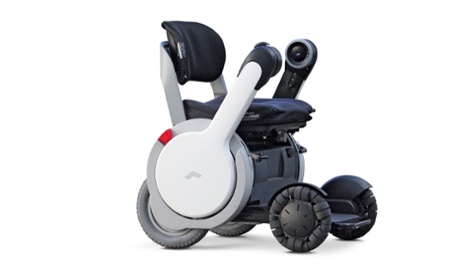
Whill
Looking like what you might get if Apple turned its sleek, minimalist hand to wheelchair design, the Whill is the product of a new startup company formed by a group of former Nissan and Toyota designers and engineers, working in Tokyo and San Francisco. Its major innovation is the incorporation of a pair of “omniwheels” at the front, which consist of normal wheels surrounded by 24 separate tyres that can rotate perpendicularly to the direction of travel. They give the chair an incredibly tight turning radius for indoor use (71cm to be precise), while four-wheel drive allows the chair to travel with ease across rough terrain, from snow and grass to sand and gravel. It is controlled by a unique mouse-like device on the arm, while the level of acceleration and steering responsiveness can be adjusted on an accompanying smartphone app. In sum, it has all the futuristic styling and precision controls that Professor X could ever dream of.
Will retail from $9,500 when released in the US this autumn
Mountain trike
The Bear Grylls of the wheelchair world, the Mountain Trike has already been used to scale Snowdon and Ben Nevis, and been taken on safari across Africa. Designed by Tim Morgan while in his final year of design engineering at the University of Bath, the chair is intended to be the equivalent of a mountain bike for wheelchair users. Developed in partnership with injured soldiers at the British Army Rehabilitation Centre at Headley Court in Surrey, it features pump-action levers that amplify arm power and prevent muddy hands, while also allowing single-handed steering. A single wheel at the back provides stability when travelling uphill, removing the fear of tipping over, while a pair of anti-tip wheels at the front provide the same reassurance when going downhill. Independent suspension on each wheel gives a smooth and comfortable ride when dropping off curbs or riding over cobbles, cracked pavements and tree roots; it also means you can turn or travel across slopes with confidence.
Ultra long-distance wheelchair
The brainchild of industrial designer Andrew Mitchell, this stealthy arrow of a wheelchair is based on the low-slung, aerodynamic form of a racing chair, but it has been cleverly optimised for long-distance use. Employing technology developed for racing bike frames, its streamlined two-part chassis is made from a thin carbon fibre shell over an expanded foam core, the two arms pivoted with adjustable suspension to suit the road surface. The rider sits in an adjustable hammock, suspended from the frame, while the seating position has been designed to keep the shoulders over the front edge of the driving wheels, in order to engage the whole body and provide maximum power. If it looks too good to be true then, well, that’s because it is – sadly it’s just a concept design, with no plans for manufacture.
Chair 4 Life
Developed by design consultancy the Renfrew Group, for the NHS National Innovation Centre, the Chair 4 Life is the wheelchair that grows with you. Designed to be easily adaptable for growing children, it consists of a standard chassis that can be adapted with a catalogue of attachments and bespoke components. It incorporates a vertical lift to allow kids to see eye-to-eye with their peers, while an automatically adjustable wheelbase allows the user to adapt the chair to suit indoor or outdoor conditions. A wider, longer track provides stability when it is needed and compactness for manoeuvrability in smaller spaces, enabling greater freedom and independence. “See the child, not the chair” was the motivating idea behind the design – although the lurid colour scheme and chunky styling means it’s quite obvious, like some intriguing mutant insect. The Department of Health is currently reviewing the design for possible procurement.
Tankchair
What happens when a combat veteran turns his hand to designing a wheelchair? The answer can be found in the form of the Tankchair, the most heavy-duty mobility aid of them all. It was invented by ex-army Arizonan Brad Soden for his wife, Liz, after she broke her back in a truck accident. The inspiration for the design came from his father-in-law, who turned up as Soden was taking apart a conventional wheelchair in his garage one day and said: “Wouldn’t it be cool if you could put tracks on that like a tank?” The result is a hefty steel chassis supported by two gigantic caterpillar tracks, “capable of conquering sand, snow, gravel, rocks and mud” with their 12-inch wide rubber treads, and able to climb a gradient as steep as 10%. Soden has since produced a souped-up Speedster version, and is working on the Mongo, the mother of all power-chairs, which is capable of towing an 800kg trailer. Useful when you get a bit carried away with the grocery shopping.

